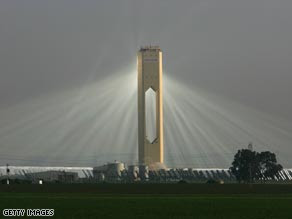 LONDON, England-Widespread anxiety about the damaging effects of burning fossil fuels, coupled with a genuine fear that oil and gas will become scarce before the century ends are fueling a renewed interest in renewable energy and, in particular, solar power solutions.Not since the 1970's, when the energy crisis forced oil prices through the roof, have solar power solutions been so warmly received.Most people associate solar power with shiny black panels-called photovoltaic cells (PV's)-which nestle on rooftops trapping the heat from the sun and converting it into electricity.But sightings of solar panels on suburban streets remain rare, not least because of the prohibitive cost of purchase and installation.But there are other ways of capturing the power of the sun which may provide a considerable chunk of our energy needs in the years ahead. Research is increasingly focusing on 'concentrated solar power' systems-CSP for short.
LONDON, England-Widespread anxiety about the damaging effects of burning fossil fuels, coupled with a genuine fear that oil and gas will become scarce before the century ends are fueling a renewed interest in renewable energy and, in particular, solar power solutions.Not since the 1970's, when the energy crisis forced oil prices through the roof, have solar power solutions been so warmly received.Most people associate solar power with shiny black panels-called photovoltaic cells (PV's)-which nestle on rooftops trapping the heat from the sun and converting it into electricity.But sightings of solar panels on suburban streets remain rare, not least because of the prohibitive cost of purchase and installation.But there are other ways of capturing the power of the sun which may provide a considerable chunk of our energy needs in the years ahead. Research is increasingly focusing on 'concentrated solar power' systems-CSP for short.CSP systems focus direct solar radiation through optical devices onto an area where a receiver is located-much like burning a hole in a piece of paper with a magnifying glass. This solar radiation is then converted into electricity.In practice, the CPS system comprises of four elements - a solar field, solar collector elements, a solar receiver and a balance of plant (the remaining systems required to operate a power plant).A range of concepts literally aimed capturing the sun's energy are currently in operation or being tested.Parabolic troughs have been in operation since the mid-1980's. Some of the most notable are the nine power plants built in the Californian desert. Still in operation today, they create 354 MW of energy in total and remain the world's largest collection of concentrating solar power plants.In Europe, a number of solar projects are being rolled out. Germany leads the way with over 10 solar power plants. Located in the Tabernas Desert in southern Spain, however, is the Platforma Solar de Almeria-a solar power research facility where new solar technologies are being tested.One of the concepts being trialed is the 'central tower' configuration which utilizes a collection of heliostats-mirrors which automatically track sunlight-which act as solar collectors. The heliostats then concentrate the solar radiation onto a central receiver located at the top of a tower.Europe's first commercial concentrated solar power plant was officially opened in Seville, Spain in March 2007. The new Planta Solar 10 (PS10) is the first commercial solar thermoelectric power plant in the world.624 large heliostats focus the sun's rays on to a single solar receiver 115 meters high.With temperatures reaching up to 250 degrees Celsius, the solar receiver then turns water into steam, which in turn powers a turbine.It has a peak capacity of 11 MW which is enough to generate 23 million kWh of electricity per year. That's enough to power 6,000 homes and save 18,000 tons of carbon emissions every year.A second tower, the PS20, is currently under construction and will produce around a peak of around 20 MW of electricity.Using troughs, dishes and towers aren't always necessary when creating solar energy.Other more rudimentary methods, first conceived over a quarter of a century ago, are once more the subject of serious consideration.Once such idea is the 'Energy Tower'. If the project ever becomes financially viable it will create some of the tallest structures on earth, dwarfing even the new 800 meter Burj Dubai tower in the United Arab Emirates.Originally patented as the 'Water Spray Down Draft Energy Tower' by Dr Philip Carlson in 1975, the project has, since 1982, been researched and promoted by Professor Dan Zaslavsky from Technion, the Israel Institute of Technology in Haifa.The 'Energy Tower' produces electricity by pumping water up to the top of a chimney and then spraying it inside. As a consequence the hot air at the top of the chimney makes the water evaporate, thus cooling the air and making it denser. This cooler air then falls down the chimney shaft causing a downdraft which is used to power turbines..
To read more go to:
http://edition.cnn.com/2007/TECH/12/10/fsummit.climate.solarpower/index.html?iref=mpstoryview
As in the days of Noah....






















































































.bmp)

























.bmp)